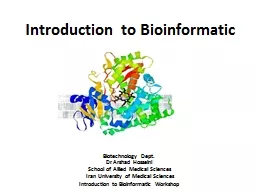

School of Allied Medical Sciences Iran University of Medical Sciences Introduction to Bioinformatic Workshop Introduction to Bioinformatic What is bioinformatics Bioinformatics ID: 912619
Download Presentation The PPT/PDF document "Biotechnology Dept. Dr Arshad Hosseini" is the property of its rightful owner. Permission is granted to download and print the materials on this web site for personal, non-commercial use only, and to display it on your personal computer provided you do not modify the materials and that you retain all copyright notices contained in the materials. By downloading content from our website, you accept the terms of this agreement.
Slide1
Biotechnology Dept.Dr Arshad HosseiniSchool of Allied Medical Sciences Iran University of Medical SciencesIntroduction to Bioinformatic Workshop
Introduction to Bioinformatic
Slide2What is bioinformatics?
Bioinformatics: word was coined in 1978
Bio-
: life
Informatics: information systems & computer scienceAnalysis of molecular biology data using techniques from information systemscomputer scienceartificial intelligencestatisticsmathematics~computational biologyMolecular biology data? DNA, RNA, genes, proteins…
Slide3Important sub-disciplines within bioinformaticsDevelopment of new algorithms and statistics with which to assess relationships among members of large data setsAnalysis and interpretation of various types of data including nucleotide and amino acid sequences, protein domains, and protein structuresDevelopment and implementation of tools that enable efficient access and management of different types of information” (NCBI)“All biological computing are not bioinformatics, e.g. mathematical modelling is not bioinformatics, even when connected with biology-related problems
Slide44
Bioinformatics
Computer
Network
Computational
Theory
Database
Software
Engineering
Artificial
Intelligence
Bio inspired
Computing
Graphic
Computing
Image
Processing
Parallel
Computing
Optimization
Internet
Bioinformatics
Data
Structure
Slide5Health
Disease prevention:
Detect
people at risk
Change of lifestyle, diet… e.g. risk of cardiovascular diseases – exercise… Study virus evolutione.g. bird flu virus Treatment: Quantitative evaluation of disease spread Rational drug designe.g. first efficient drug against HIV (
Norvir
1996)
Gene
therapy
e.g. “bubble” kids with no immune system Animal model e.g. zebra fish is the new mouseAim of bioinformatics
“To improve the quality of life” by understanding how it works
Slide6Forensic
(DNA fingerprints) Criminal
suspects
(UK: database of 3M people)
Paternity tests Identification of victims (Titanic, earthquakes…) Prevent illegal trade (drugs, ivory…)Paleoanthropology & archaeology Human evolution
e.g. where is the first American from?
Food industry
GMOs
(Genetically Modified Organisms)
Famine buster or Frankenfood?Other applications
Slide7Big GoalDiscovery of new biological insights Create a global perspective of living system Formulate unifying principles in biology
From ‘unknown’ to ‘known’ Fast , efficient way to extract information
Slide8Bioinformatics vs Computational BiologyAlmost interchangeableComputational biology may be broaderComputational biology is an interdisciplinary field that applies the techniques of computer science, applied mathematics and statistics to address biological problems
Includes bioinformatics
Slide9Impacts of BioinformaticsOn biological sciences (and medical sciences)Large scale experimental techniques Information growthOn computational sciencesBiological has become a large source for new algorithmic and statistical problems!
Slide10Related FieldsProteomics/genomics (metagenomics)/ comparative genomics/structural genomicsChemical informaticsHealth informatics/Biomedical informaticsComplex systemsSystems biologyBiophysics Mathematical biologytackles biological problems using methods that need not be numerical and need not be implemented in software or hardware
Slide11Bioinformatics Problems/Applications
Slide12Bioinformatics Flow Chart (0)6. Gene & Protein expression data
7. Drug screening
Ab initio
drug design OR
Drug compound screening in
database of molecules
8. Genetic variability
1a. Sequencing
1b. Analysis of nucleic acid seq.
2. Analysis of protein seq.
3. Molecular structure prediction
4. molecular interaction
5. Metabolic and regulatory networks
Slide13Bioinformatics Flow Chart (1)1a. Sequencing
1b. Analysis of nucleic acid seq.
Base calling
Physical mapping
Fragment assembly
-
gene finding
Multiple seq alignment
evolutionary tree
Stretch of DNA coding for protein;
Analysis of noncoding region of genome
2. Analysis of protein seq.
3. Molecular structure prediction3D modeling;DNA, RNA, protein, lipid/carbohydrate
Sequence relationship4. molecular interactionProtein-protein interaction
Protein-ligand interaction5. Metabolic and regulatory networks
Slide14Bioinformatics Flow Chart (2)6. Gene & Protein expression data
7. Drug screening
EST
DNA chip/microarray
Lead compound binds tightly to binding site of target protein
Lead optimization – lead compound modified to be nontoxic,
few side effects, target deliverable
Ab initio
drug design OR
Drug compound screening in
database of molecules
8. Genetic variability
Drug molecules designed to be complementary to bindingSites with physiochemical and steric restrictions.
Now investigated at the genome scaleSNP, SAGE
Slide1515Why is Bioinformatics Important?Applications areas includeMedicinePharmaceutical drug designToxicologyMolecular evolutionBiosensorsBiomaterialsBiological computing modelsDNA computing
Slide1616Why is bioinformatics hot?Supply/demand: few people adequately trained in both biology and computer scienceGenome sequencing, microarrays, etc lead to large amounts of data to be analyzedLeads to important discoveries Saves time and money
Slide17